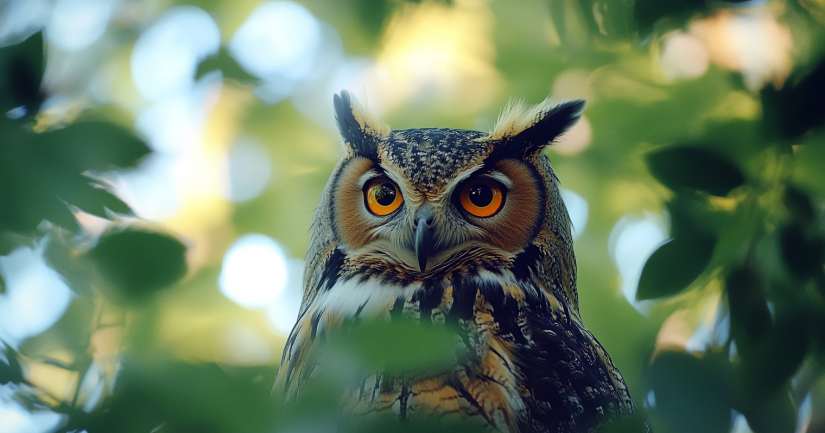
Take this engaging quiz to unveil fascinating insights about the Owl Quiz. How Well Do You Know These Mysterious Nocturnal Hunters?. Owls have long captured human fascination with their silent flight, piercing eyes, and eerie calls. This Owl Quiz will put your knowledge to the test, exploring the world of these secretive nighttime predators. Found on every continent except Antarctica, owls play a crucial role in ecosystems, keeping rodent populations in check while remaining elusive to many observers.
Owls belong to the order Strigiformes, which includes over 200 species, ranging from the tiny Elf Owl, barely the size of a sparrow, to the powerful Eurasian Eagle-Owl with a wingspan of nearly two meters. Unlike most birds, owls have forward-facing eyes, giving them excellent depth perception and a distinctive, almost human-like gaze. Their large eyes contain a high number of rod cells, allowing them to see clearly in near-total darkness.
Love the wisdom of owls? Uncover more bird trivia by visiting the vibrant Magpie Quiz or the melodic charms of the Lark Quiz.
Start the Owl Quiz Now
What Makes Owls Unique? Fascinating Facts for the Owl Quiz
One of their most remarkable adaptations is their ability to rotate their heads up to 270 degrees. This flexibility compensates for their fixed eye sockets, enabling them to scan their surroundings without moving their bodies. Their feathers are also specially structured to reduce flight noise, allowing them to approach prey undetected.
Where Do Owls Live? Exploring Their Habitats and Survival Strategies
Owls inhabit a diverse range of environments, from dense forests and open grasslands to deserts and icy tundras. Some species, like the Snowy Owl, thrive in Arctic conditions, while others, such as the Burrowing Owl, prefer open landscapes where they nest in abandoned rodent burrows. Their adaptability has even allowed some species, like the Barn Owl, to coexist in human settlements, nesting in barns, attics, and other structures.
Each owl species has evolved hunting strategies suited to its habitat. While Great Horned Owls rely on their brute strength to take down rabbits and even other birds, Scops Owls use camouflage to blend into tree bark, ambushing small prey like insects and lizards.
Why Are Owls Silent Flyers? The Science Behind Their Stealth
Unlike most birds of prey, which rely on speed and strength, owls specialize in stealth and precision. Their wings are uniquely designed to muffle sound, thanks to a combination of soft, serrated feathers that break up airflow and reduce turbulence. This adaptation allows them to swoop down on unsuspecting prey without making a sound.
Their hearing is just as impressive. Many owl species have asymmetrical ear placements, meaning one ear is slightly higher than the other. This specialized structure enables them to detect even the faintest rustle in total darkness, allowing them to pinpoint and capture prey with deadly accuracy.
Are Owls in Danger? Conservation Challenges and Efforts
While some owl species thrive, others face increasing threats due to deforestation, habitat loss, and climate change. The Spotted Owl, native to North America, has seen dramatic population declines due to logging and competition with the more adaptable Barred Owl.
In some cultures, owls are surrounded by superstition, leading to persecution and hunting. However, conservationists are working to protect these birds by preserving nesting sites, combating illegal wildlife trade, and educating the public on their ecological importance.
Are You Ready to Take the Owl Quiz?
Now that you’ve explored the unique adaptations, habitats, and survival strategies of owls, it’s time to see how much you really know! This Owl Quiz will challenge you with intriguing questions about their silent flight, nocturnal hunting skills, and extraordinary eyesight. Can you identify key facts about these mysterious birds of prey? Take the quiz now and find out!
Check out our FULL collection of Bird Quizzes!
Owl – FAQ
Owls are nocturnal birds of prey known for their unique features, including large, forward-facing eyes, a flat face, and a distinctive round head. They possess excellent night vision and acute hearing, allowing them to hunt effectively in low-light conditions.
Owls have a varied diet primarily consisting of small mammals, birds, and insects. Depending on the species and habitat, their prey can include mice, voles, rabbits, and even fish. Owls are skilled hunters, using their sharp talons to capture and kill their prey. They often swallow small animals whole and later regurgitate indigestible parts, such as bones and fur, in the form of pellets.
Different species have adapted to specific habitats, with some preferring open landscapes while others thrive in wooded regions. Their adaptability allows them to occupy diverse ecological niches.
Most owl species are solitary, preferring to hunt and roost alone. However, some species, like the great horned owl, may form temporary pairs during the breeding season. While they communicate through various calls, especially during mating, they do not typically exhibit strong social behaviors like flocking.
Owls encounter several threats, including habitat loss, climate change, and pesticide exposure. Urbanization reduces their natural habitats, making it harder for them to find food and nesting sites. Additionally, some species are threatened by hunting and trapping. Conservation efforts are crucial to protect these fascinating birds and their ecosystems.
